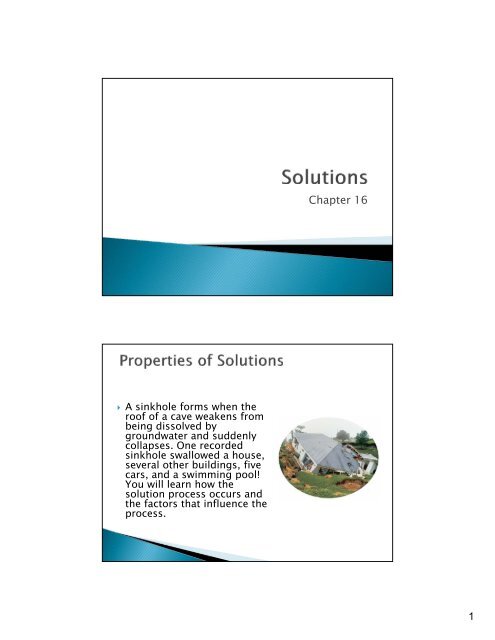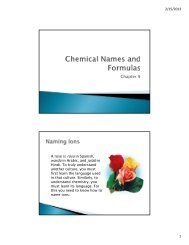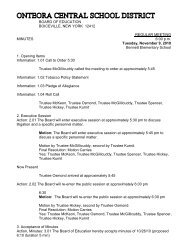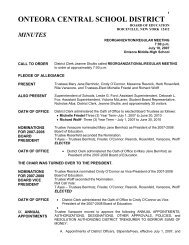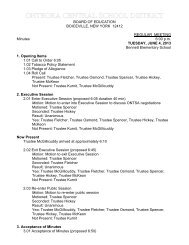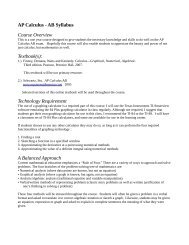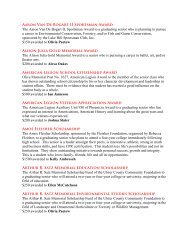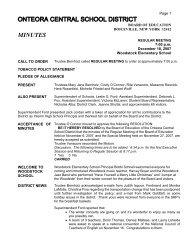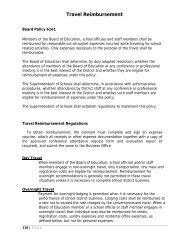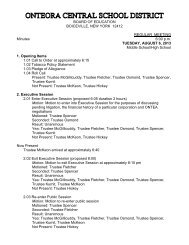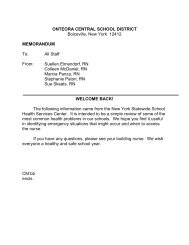Chapter 16 - Solutions
Chapter 16 - Solutions
Chapter 16 - Solutions
Create successful ePaper yourself
Turn your PDF publications into a flip-book with our unique Google optimized e-Paper software.
<strong>16</strong>.1• A saturated solution contains the maximum amount ofsolute for a given quantity of solvent at a giventemperature and pressure.• An unsaturated solution contains less solute than asaturated solution at a given temperature andpressure.<strong>16</strong>.1• In a saturated solution, the rate ofdissolving equals the rate ofcrystallization, so the total amountof dissolved solute remainsconstant.• This is a dynamic equilibrium.5
<strong>16</strong>.1• The solubility of a substance is the amount of solute thatdissolves in a given quantity of a solvent at a specifiedtemperature and pressure to produce a saturated solution.• Solubility is often expressed in grams of solute per 100 gof solvent.• Reference table G6
<strong>16</strong>.1• Some liquids combine in all proportions, while othersdon’t mix at all.• Two liquids are miscible if they dissolve in each other inall proportions.• Two liquids are immiscible if they are insoluble in eachother.<strong>16</strong>.1• Oil and water are immiscible.7
<strong>16</strong>.1• Vinegar and oil are immiscible.<strong>16</strong>.1• The mineral depositsaround hot springs resultfrom the cooling of thehot, saturated solution ofminerals emerging fromthe spring.8
<strong>16</strong>.1 Factors Affecting Solubility◦ What conditions determine the amount of solutethat will dissolve in a given solvent?<strong>16</strong>.1◦ Temperature affects the solubility of solid, liquid,and gaseous solutes in a solvent; both temperatureand pressure affect the solubility of gaseoussolutes.9
<strong>16</strong>.1◦ Temperature• The solubility of most solid substances increases as thetemperature of the solvent increases.• The solubilities of most gases are greater in cold waterthan in hot.<strong>16</strong>.110
<strong>16</strong>.1• A supersaturated solution contains more solute than itcan theoretically hold at a given temperature.• The crystallization of a supersaturated solution can beinitiated if a very small crystal, called a seed crystal, ofthe solute is added.<strong>16</strong>.1• A supersaturated solution is clear before a seed crystalis added.11
<strong>16</strong>.1• Crystals begin to form in the solution immediatelyafter the addition of a seed crystal.<strong>16</strong>.1• Excess solute crystallizes rapidly.12
<strong>16</strong>.1◦ Pressure• Changes in pressure have little effect on the solubilityof solids and liquids, but pressure strongly influencesthe solubility of gases.• Gas solubility increases as the partial pressure of thegas above the solution increases.<strong>16</strong>.2◦ Water must be tested continuallyto ensure that the concentrationsof contaminants do not exceedestablished limits. Thesecontaminants include metals,pesticides, bacteria, and even theby-products of water treatment.You will learn how solutionconcentrations are calculated.13
<strong>16</strong>.2• The concentration of a solution is a measure of theamount of solute that is dissolved in a given quantityof solvent.• A dilute solution is one that contains a small amount ofsolute.• A concentrated solution contains a large amount of solute.<strong>16</strong>.2• Molarity (M) is the number of moles of solute dissolvedin one liter of solution.• To calculate the molarity of a solution, divide themoles of solute by the volume of the solution.• Reference Table T14
<strong>16</strong>.2• To make a 0.5-molar (0.5M) solution, first add 0.5 molof solute to a 1-L volumetric flask half filled withdistilled water.<strong>16</strong>.2• Swirl the flask carefully to dissolve the solute.15
<strong>16</strong>.2• Fill the flask with water exactly to the 1-L mark.<strong>16</strong>.2<strong>16</strong>
for Sample Problem <strong>16</strong>.2A solution has a volume of 2.0 L and contains 36.0 g ofglucose (C 6 H 12 O 6 ). If the molar mass of glucose is 180g/mol, what is the molarity of the solution?<strong>16</strong>.317
How many moles for Sample of solute Problem are <strong>16</strong>.3 in 250 mL of 2.0 MCaCl 2 ? How many grams of CaCl 2 is this?<strong>16</strong>.2 Making Dilutions◦ What effect does dilution have on the total moles ofsolute in a solution?◦ Diluting a solution reduces the number of moles ofsolute per unit volume, but the total number ofmoles of solute in solution does not change.18
<strong>16</strong>.2• The total number of moles of solute remains unchangedupon dilution, so you can write this equation.• M 1 and V 1 are the molarity and volume of the initialsolution, and M 2 and V 2 are the molarity and volume ofthe diluted solution.• Write this in your reference table T.<strong>16</strong>.2• Making a Dilute Solution19
<strong>16</strong>.2• To prepare 100 ml of 0.40M MgSO 4 from a stocksolution of 2.0M MgSO 4 , a student first measures 20mL of the stock solution with a 20-mL pipet.<strong>16</strong>.2• She then transfers the 20 mL to a 100-mL volumetricflask.20
<strong>16</strong>.2• Finally she carefully adds water to the mark to make100 mL of solution.<strong>16</strong>.2• Volume-Measuring Devices21
<strong>16</strong>.4How many milliliters for Sample of Problem a solution <strong>16</strong>.4 of 4.00M KI are needed toprepare 250.0 mL of 0.760M KI?`22
<strong>16</strong>.2 Percent <strong>Solutions</strong>◦ What are two ways to express the percentconcentration of a solution?1. as the ratio of the volume of the solute to thevolume of the solution or2. as the ratio of the mass of the solute to the massof the solution.<strong>16</strong>.2◦ Concentration in Percent (Volume/Volume)23
<strong>16</strong>.2• Isopropyl alcohol (2-propanol) is sold as a 91%solution. This solution consist of 91 mL of isopropylalcohol mixed with enough water to make 100 mL ofsolution.24
A bottle of antiseptic hydrogen peroxide(H2O2) is labeled 3.0% (v/v). How many mL ofH 2 O 2 are in a 400.0 mL bottle of thissolution?<strong>16</strong>.2◦ Concentration in Percent (Mass/Mass)25
<strong>16</strong>.3 The wood frog is a remarkable creature because itcan survive being frozen. Scientists believe that asubstance in the cells of this frog acts as a naturalantifreeze, which prevents the cells from freezing.You will discover how a solute can change thefreezing point of a solution.<strong>16</strong>.3• A property that depends only upon the number ofsolute particles, and not upon their identity, is called acolligative property.26
<strong>16</strong>.3◦ Three important colligative properties of solutionsare1. vapor-pressure lowering2. boiling-point elevation3. freezing-point depression<strong>16</strong>.3• In a pure solvent, equilibrium is established betweenthe liquid and the vapor.27
<strong>16</strong>.3• In a solution, solute particles reduce the number offree solvent particles able to escape the liquid.Equilibrium is established at a lower vapor pressure.<strong>16</strong>.3◦ The decrease in a solution’s vapor pressure isproportional to the number of particles the solutemakes in solution.28
<strong>16</strong>.3• Three moles of glucose dissolved in water produce 3mol of particles because glucose does not dissociate.<strong>16</strong>.3• Three moles of sodium chloride dissolved in waterproduce 6 mol of particles because each formula unitof NaCl dissociates into two ions.29
<strong>16</strong>.3• Three moles of calcium chloride dissolved in waterproduce 9 mol of particles because each formula unitof CaCl 2 dissociates into three ions.<strong>16</strong>.3 Freezing-Point Depression◦ The difference in temperature between the freezingpoint of a solution and the freezing point of thepure solvent is the freezing-point depression.◦ What determines the amount by which a solution’sfreezing point differs from those properties of thesolvent?30
<strong>16</strong>.3◦ The magnitude of the freezing-point depression isproportional to the number of solute particles dissolvedin the solvent and does not depend upon their identity.◦ The freezing point of water decreases by 1.86°C forevery mole of particles that the solute forms whendissolved in 1000 g of water.◦ This is called the freezing point depression constant forwater.<strong>16</strong>.3• The freezing-pointdepression of aqueoussolutions makes walks anddriveways safer whenpeople sprinkle salt on icysurfaces to make ice melt.The melted ice forms asolution with a lowerfreezing point than that ofpure water.31
<strong>16</strong>.3 Boiling-Point Elevation• The difference in temperature between the boilingpoint of a solution and the boiling point of the puresolvent is the boiling-point elevation.• The same antifreeze added to automobile engines toprevent freeze-ups in winter, protects the engine fromboiling over in summer.<strong>16</strong>.3• The magnitude of the boiling-point elevation isproportional to the number of solute particlesdissolved in the solvent.• The boiling point of water increases by 0.512°C forevery mole of particles that the solute forms whendissolved in 1000 g of water.• This is called the boiling point elevation constant forwater.32
<strong>16</strong>.4 Cooking instructions often call for theaddition of a small amount of salt to thecooking water. Dissolved salt elevates theboiling point of water. You will learn how tocalculate the amount the boiling point of thecooking water rises. My favorite “pasta pot” is a 3 qt. stockpot. Igenerally add about ½ tsp. salt to 2 qt. water. Atwhat T will the water boil at standard pressure? 1tsp salt weighs 20 g. The molar mass of NaCl is58.44 g/mol.33
<strong>16</strong>.4◦ What are two more ways of expressing theconcentration of a solution?◦ The unit molality and mole fractions are twoadditional ways in which chemists express theconcentration of a solution.<strong>16</strong>.4• The unit molality (m) is the number of moles of solutedissolved in 1 kilogram (1000 g) of solvent. Molality isalso known as molal concentration.34
<strong>16</strong>.4• To make a 0.500msolution of NaCl, use abalance to measure 1.000kg of water and add 0.500mol (29.3 g) of NaCl.<strong>16</strong>.4• Ethlylene Glycol (EG) is added to water as antifreeze.35
<strong>16</strong>.6How many grams of sodium fluoride are needed to prepare a0.400m NaF solution that contains 750 g of water?36
<strong>16</strong>.4 Freezing-Point Depression and Boiling-PointElevation• How are freezing-point depression and boiling-pointelevation related to molality?• The magnitudes of the freezing-point depression (ΔT f )and the boiling-point elevation (ΔT b ) of a solution aredirectly proportional to the molal concentration (m), whenthe solute is molecular, not ionic.<strong>16</strong>.4• The constant, K f , is the molal freezing-pointdepression constant, which is equal to the change infreezing point for a 1-molal solution of a nonvolatilemolecular solute.37
• The constant, K b , is the molal boiling-point elevationconstant, which is equal to the change in boiling pointfor a 1-molal solution of a nonvolatile molecularsolute.38
<strong>16</strong>.8for Sample Problem <strong>16</strong>.8What is the freezing point depression of an aqueous solutionof 10.0 g of glucose (C 6 H 6 O 12 ) in 50.0 g H 2 O?40
<strong>16</strong>.9for Sample Problem <strong>16</strong>.9What mass of NaCl would have to be dissolved in 1.000 kgof water to raise the boiling point by 2.00 o C?41


